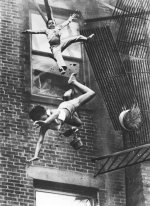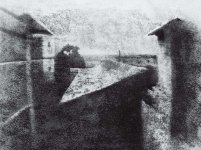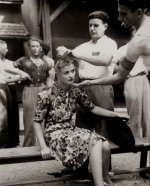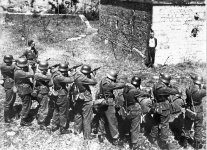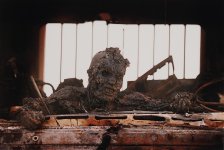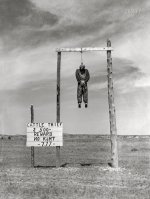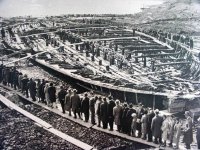Georges Blind, a member of the French resistance, smiling at a German firing squad, 1944
This was a mock execution attempting to get the resistance fighter, Georges Blind, to talk. It didn?t work. Georges did not divulge any information. It?s interesting how they?ve placed him at the corner of the building rather than against the stereotypical flat wall. It must make ricochet injuries to the firing squad members much less likely.
Of course, this was a mock execution, but most likely they used the same site for real executions. Georges Blind was eventually forwarded to a concentration camp, where he was selected for termination on arrival, dying some time in late November 1944.
A mock execution is a stratagem in which a victim is deliberately but falsely made to feel that his execution or that of another person is imminent or is taking place. It may be staged for an audience or a subject who is made to believe that he is being led to his own execution.
This might involve blindfolding the subjects, making them recount last wishes, making them dig their own grave, holding an unloaded gun to their head and pulling the trigger, shooting near (but not at) the victim, or firing blanks. Mock execution is categorized as psychological torture.
There is a sense of fear-induced when a person is made to feel that they are about to be executed or witness someone being executed. Mock execution is considered psychological torture because there is no physical harm caused, but there is mental harm.
Psychological harm is caused because the victim?s suspense level increases while awaiting their death or someone else?s, which is considered torture. The psychological trauma begins to occur when the victim realizes that they are about to be executed.
The psychological trauma results in permanent damage equivalent to the aftermath of physical torture. The buildup of anxiety due to mock execution could influence the end result of the staged death.
Usually, the mock executions were done to intimidate and let people in occupied Europe not to mess with the Germans. The Germans thought the best way to fight resistance movements was to be utterly brutal in putting it down. If a village housed a few fighters, they would just take out the whole village.
They had whole SS squads dedicated to this. They would also incorporate any local police forces, so they had a good lay of the land and a line to insider info. A lot of these local police forces helped the Germans because they were so scared themselves and got some preferential treatment.
Also, this was Hitler?s strategy in the East from the start. Any village suspected of hosting partisans would have all of its men executed, at the very least. The extermination of Communist Party commissars and Jews was also ordered and was mixed in with these ?anti-partisan? activities in an effort to hide the reality of Hitler?s war of annihilation.
This is identical to the French response against Spanish partisans after Napoleon?s invasion of Spain. The French troops could not fight the English/Portuguese while the Spanish terrorized their supply lines. For every French soldier killed by partisans, X number of civilians would be executed.
The firing squads are large so that no one man is solely responsible for the killing. In some cases, one or more members of the firing squad may be issued a weapon containing a blank cartridge instead of one housing a live round.
No member of the firing squad is told beforehand if he is using live ammunition. This is believed to reinforce the sense of diffusion of responsibility among the firing squad members, making the execution process more reliable.
It also allows each member of the firing squad to believe afterward that he did not personally fire a fatal shot?for this reason, it is sometimes referred to as the ?conscience round?. However, a military firing squad in the field performing a martial execution ad-hoc, as seen here, is not likely to observe this nicety.


